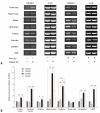The ketogenic diet suppresses the cathepsin E expression induced by kainic acid in the rat brain
- PMID: 20635438
- PMCID: PMC2908849
- DOI: 10.3349/ymj.2010.51.5.653
The ketogenic diet suppresses the cathepsin E expression induced by kainic acid in the rat brain
Abstract
Purpose: The ketogenic diet has long been used to treat epilepsy, but its mechanism is not yet clearly understood. To explore the potential mechanism, we analyzed the changes in gene expression induced by the ketogenic diet in the rat kainic acid (KA) epilepsy model.
Materials and methods: KA-administered rats were fed the ketogenic diet or a normal diet for 4 weeks, and microarray analysis was performed with their brain tissues. The effects of the ketogenic diet on cathepsin E messenger ribonucleic acid (mRNA) expression were analyzed in KA-administered and normal saline-administered groups with semi-quantitative and real-time reverse transcription polymerase chain reaction (RT-PCR). Brain tissues were dissected into 8 regions to compare differential effects of the ketogenic diet on cathepsin E mRNA expression. Immunohistochemistry with an anti-cathepsin E antibody was performed on slides of hippocampus obtained from whole brain paraffin blocks.
Results: The microarray data and subsequent RT-PCR experiments showed that KA increased the mRNA expression of cathepsin E, known to be related to neuronal cell death, in most brain areas except the brain stem, and these increases of cathepsin E mRNA expression were suppressed by the ketogenic diet. The expression of cathepsin E mRNA in the control group, however, was not significantly affected by the ketogenic diet. The change in cathepsin E mRNA expression was greatest in the hippocampus. The protein level of cathepsin E in the hippocampus of KA-administered rat was elevated in immunohistochemistry and the ketogenic diet suppressed this increase.
Conclusion: Our results showed that KA administration increased cathepsin E expression in the rat brain and its increase was suppressed by the ketogenic diet.
Conflict of interest statement
The authors have no financial conflicts of interest.
Figures




References
-
- Wilder RM. The effects of ketonemia on the course of epilepsy. Mayo Clin Bull. 1921;2:307–308.
-
- Huffman J, Kossoff EH. State of the ketogenic diet(s) in epilepsy. Curr Neurol Neurosci Rep. 2006;6:332–340. - PubMed
-
- Cross JH, Neal EG. The ketogenic diet-update on recent clinical trials. Epilepsia. 2008;49(Suppl 8):6–10. - PubMed
-
- Kossoff EH, McGrogan JR. Worldwide use of the ketogenic diet. Epilepsia. 2005;46:280–289. - PubMed
-
- Freeman J, Veggiotti P, Lanzi G, Tagliabue A, Perucca E Institute Neurology IRCCS C. Mondino Foundation. The ketogenic diet: From molecular mechanisms to clinical effects. Epilepsy Res. 2006;68:145–180. - PubMed
Publication types
MeSH terms
Substances
LinkOut - more resources
Full Text Sources
Molecular Biology Databases

